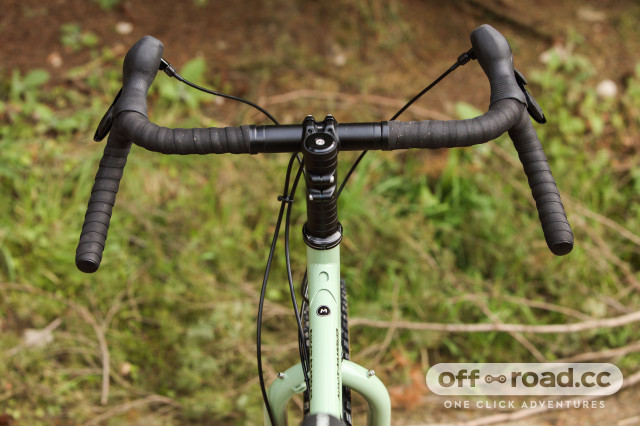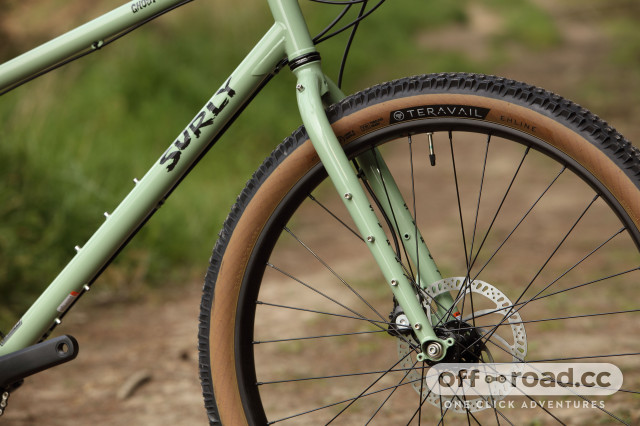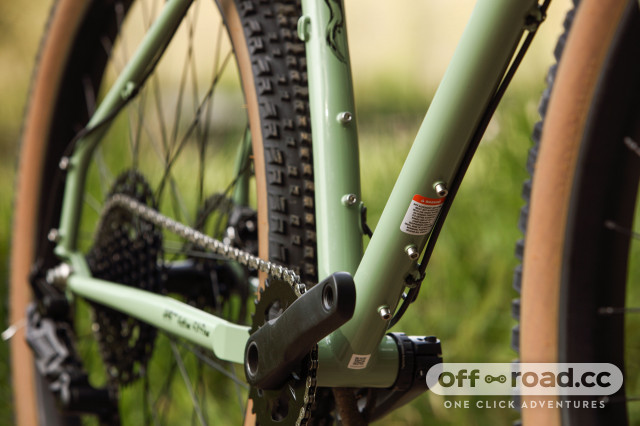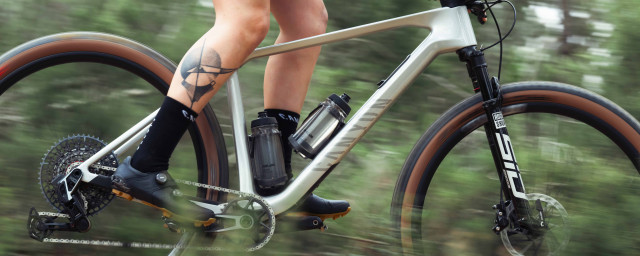The geometry is certainly interesting, as are the looks, but Surly’s Grappler is one very capable machine with huge tyre clearance and sweet handling whether you are blasting down your local singletrack or heading into the wilderness fully loaded up for an adventure. While it doesn't conform to the traditional traits of the best gravel bikes, it certainly has the attributes to hold its own not to mention surpass many other drop-bar bikes when the trail gets gnarly.
- Gravel bike vs mountain bike: what are the differences?
- Cotic Cascade review
- Best gravel bikes under £1,500
Surly Grappler - Ride
The Grappler is a lovely bike to ride, and way more fun than I was expecting. It isn’t the type of bike I’d normally ride with the majority of my gravel rides taking place on more lightweight, road-influenced machines. But when the chance came up to review the Grappler I was intrigued. For a start, it’s quite a heavy bike at around 13.4kg, but it doesn’t really behave like one.
> Buy now: Surly Grappler Frameset from eBay for £899.03
Sure, you aren’t going to be hunkering in for a sprint session or attacking your local steep climbs but thanks to the low gearing it rolls along nicely on the trails and when you hit a hill you can maintain a spinny cadence to save your legs and get to the top.
The large volume tyres absorb the tree roots and rocks which also helps you keep that cadence up which makes long draggy sections less of a chore, and even relaxing. If you are riding unknown routes this takes a lot of the stress away as you aren’t having to study the trail so much allowing you to focus on the route ahead for planning.
The lengthy wheelbase brings stability, too, which helps in all conditions, wet or dry, and it’s a blessing on descents, especially with the bike loaded up. For the majority of descents, you’ll be freewheeling due to the tiny chainring but that wheelbase along with a stable front end means that the Surly feels very surefooted and confidence-inspiring even when the speed is really ramping up.
The handling is quick enough that it is fun in the bends especially when unloaded, but it is also predictable which is a massive boost when covering big miles with a load of kit onboard. Stability is added by the inclusion of a dropper post for technical sections.
The only downside to that speed is that the Surly comes with cable-operated discs, and even with the larger diameter 180mm rotor found on the front (larger than you would get on most gravel bikes), they just lack the punch of a quality hydraulic system. So much so, that I never really felt comfortable just letting the Grappler run free. The frameset is capable of more.
The geometry with the tall front end works really well for the type of riding the Grappler is intended for. It reduces weight over the front end when carving your way through narrow trails and puts you in a position where you can see a long way up the route. It also reduces fatigue in your wrists or lower back on longer rides.
Big tyres bring comfort, there is no doubting that, but even at low pressures you can’t hide a poor ride quality. With the tyres pumped up for a bit of tarmac action that recognisable smooth feel of steel tubing comes through. It’s not as sublime as that found on higher-end tube sets, but this is a workhorse that could well be found out in the back of beyond where you need reliability and being able to take a knock or three without failure.
This frameset brings a blend of both and on the whole, the Grappler offers a ride quality that’ll appeal to all kinds of off-roaders.
Surly Grappler - Frame & Fork
Surly says that off-road enthusiasts have been Frankensteining drop bars onto trail bikes for decades and that they have designed the Grappler to ‘scratch that itch.’
Ben Jungbauer, Surly’s engineer designed the bike by starting with the handlebar. That’s generally an odd way round to do it, but basically, he determined where the best position for the handlebar to sit height-wise and designed the rest of the frame from there.
Using a drop bar has meant that the Grappler has a larger reach and stack figures compared to Surly’s flat-barred line-up. On this medium model that equates to a reach of 420mm, and a stack of 623mm. The top tube length is 610mm with a 60mm stem and a head tube length of 200mm. A very different setup from the mainstream gravel bikes on the market.
That top tube length is ‘effective’ as it is heavily sloped to reduce the standover height. On technical sections or with a loaded-up bike being able to get a foot down quickly is always a bonus and keeping that measurement to just 796mm Surly has achieved that.
The Grappler’s head angle is 69.5° which was arrived at after much testing of steeper and slacker angles. The seat tube angle is much steeper at 73°. The wheelbase is lengthy at 1,109mm which brings the stability I mentioned in the ride section above. Other measurements for this medium frame are a bottom bracket drop of 50mm, a seat tube length of 437.2mm, and chainstays that are 425mm in length. The fork rake is 50mm.
The Grappler is available in five sizes with full geometry details available on Surly’s website.
As for the construction, the Grappler is built using Surly’s Natch Chromoly steel tubing which is double-butted for the main triangle and TIG welded. The Dinner Fork is made from the same tubing with double-butted legs.
For the rear hub, the Grappler’s frame uses 145mm of rearward facing, horizontal ‘Gnot-Boost’ dropouts with a vertical drop slot. This design takes advantage of the steel frame's flexibility which can be pulled or pushed to take 12mm x 148mm or 142mm axles. The fork offers the more conventional boost setup of 15mm x 110mm.
Brake rotor-wise, both front, and rear will accept up to 203mm maximum.
Tyre clearance is 27.5-inch x 2.8in or 29-inch x 2.2in for the fork dropping to 27.5-inch x 2.6in/29 x 2.0in with mudguards fitted. For the frame, you are looking at 27.5-inch x 3in (27.5-inch x 2.8in with mudguard) or 29-inch x 2.1 – 2.5in with or without mudguard. If you have the wheel all the way forward in the vertical dropouts that are 2.1in, all the way back, that allows 2.5in.
There are mounts aplenty as you’d expect with three-pack mounts on each fork leg, three-pack mounts on the upper and lower down tube, plus seat tube mounted bottle cage mounts. Both the fork and frame will accept racks and mudguards, you also get full internal dropper post mounting.
Away from the technical stuff, it’s worth noting that the Surly is well made, with tidy welding throughout and neat attention to detail. The green paint job suits the bike and it’s also tough enough to cope with all of the abuse you are likely to throw at it during its lifetime.
Surly Grappler - Finishing kit
The Grappler is available as a frameset or this single build, and to be honest if it was money, I’d be going down the frameset route as I think the kit, especially the groupset is a bit of a let-down.
Our bike uses Microshift AdventX dual control levers, Microshift M6205 10-speed rear mech, and 11-48T cassette. The overall performance is decent enough. The shifting isn’t quite as slick as Sram and Shimano under heavy load, and it isn’t as quick either way the chain is traveling across the cassette. The shifts are clean though and you feel the positive clunk of the chain through the lever.
It’s the lever’s shape that I don’t like though. I didn’t feel that they sit nicely in the hands and occasionally the shifter could catch my skin after each gear change. The plastic brake levers also lack feel and feedback.
There are also some big jumps across the cassette. Not a massive problem on a bike like this really, as you aren’t exactly going to be trying to stick to an ideal cadence or anything. The larger four cogs though are 28-34-40-48T which can mean the difference between groveling or spinning uphill with nothing in between.
Microshift doesn’t offer a chainset so Surly has specced a Samox Boost with a 1x 32T chainring. It worked well throughout testing running smoothly, and I had no issues with the chain wanting to leave the chainring on rough terrain.
The braking is taken care of by Tektro with their Mira MD-C400 calipers. As I mentioned earlier, they lack the bite of a quality hydraulic system, and the modulation.
They took a few miles to bed in before performance was what I’d call acceptable for a bike that is capable of being loaded up, and from then on in they provided enough power for the majority of scenarios. All except for those quick downhills.
For the contact points, the Grappler uses a Salsa Cowchipper handlebar and a WTB Volt 142 saddle. The bar is 44cm wide on a medium bike with 24-degrees of flare in total giving a very wide stance in the drops. Ideal for added stability on the downhills or when traveling quickly on the flat. It also gives you plenty of room for a large bar bag.
I’ve sat on top of the WTB Volt 142 saddle on many test bikes, and while it’s quite a basic, simple shape it is something that I get on with quite well. It’s well suited to a position where you are likely to spend a lot of time in the saddle with plenty of padding that is firm enough to not cause any hot-spots.
The TransX YSP15 dropper seatpost has 100mm of travel which works well with the low standover height of the bike. It’s smooth in operation too from the lefthand Microshift AdventX lever.
WTB also supply the wheels, well the rims at least with their ST i40 TCS mated to Novatec hubs. It’s a tough build and I certainly had no issues with the wheelset throughout testing hitting some deep ruts from the dried-out ground, and plenty of rocks too on the local military gravel roads.
The tyres are Teravail Ehline which worked well in all kinds of conditions, not feeling sluggish on hardpacked tracks and biting in when the conditions were soft or very wet. Punctures weren’t an issue, and neither was damage from the rough tracks I rode the Surly on.
Surly Grappler - Value
The Grappler is available in the UK for £850 for the frameset and £2,200 for this build.
The steel All-City Gorilla Monsoon has a more traditional geometry, but is also designed for load lugging and wearing big tyres. A frameset for one of those will set you back £1,200.
Cotic’s Cascade impressed Mat when he recently reviewed it. It follows a similar theme to the Surly geometry-wise but comes with a Reynolds 853 main triangle with a 4130 Chromoly rear end. It uses the same groupset as the Ghost Grappler in terms of the gears but uses a 36T Raceface chainring, Easton EA90 cranks and Shimano cable-operated brakes. The price of the Cotic is £849 for the frameset, and £2,099 for the build reviewed, but it doesn’t include a dropper post though for that money.
Surly Grappler - Verdict
The Grappler is more hardtail mountain bike than it is a gravel bike when looking at the current designs on the market, but for someone like me who doesn’t really do flat bars, I found it a great bike to have some fun on the tracks and trails that I wouldn’t normally ride on my other gravel bikes. The gearing brings a few compromises as do the cable-operated brakes, but at its heart is a stunning steel frame that has well-designed geometry and great ride quality.

























2 comments
And cable discs on a bike in this Genre - FFS!
Honestly Im a bit unimpressed for north of 2k. NoName Steel and NoName groupset when for a smidge more you could get an 853/4130 Secan from Fairlight or the Cotic noted above with Shimano or Sram.
The frameset price isnt bad - seems like somethings been lost in the build out.